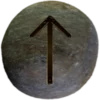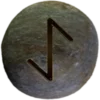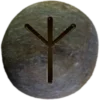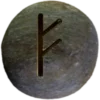Last Updated on February 21, 2025



Origins and Meaning
The Tiwaz rune (ᛏ) represents the god Týr (pronounced “TEER”). Other spellings include “Teiwaz” and “Tir.” The rune symbolizes honor, justice, and self-sacrifice. It appears in the Elder Futhark, the oldest runic alphabet used by Germanic tribes. Warriors and leaders often carved Tiwaz onto weapons and shields, seeking victory and guidance. The rune resembles an upward-pointing arrow, reflecting direction, strength, and unwavering purpose.
Tiwaz connects deeply to the mythology of Týr, a Norse god known for his courage. The Poetic Edda and Prose Edda tell of Týr’s sacrifice. In the Gylfaginning, Loki’s son Fenrir grew too powerful. The gods tricked Fenrir into chains, but he refused to submit unless one of them placed a hand in his mouth. Týr did so, knowing Fenrir would bite it off. This act made Týr a god of oaths, law, and sacrifice. ![]()
The rune’s name comes from the Proto-Germanic “Tîwaz” (pronounced “TEE-wahz”). This term links to the Indo-European root “dyeu-,” meaning “god” or “sky.” The same root appears in “Zeus” and “Deus.” Germanic cultures honored Tiwaz as a sky god long before the Viking Age. In early societies, he ranked among the highest deities. Later, Odin took his place as the chief god, but it remained important in matters of law and warfare.
Some inscriptions contain multiple Tiwaz runes, suggesting an emphasis on divine justice or protection. In the Kylver Stone, found in Gotland, Sweden, it appears as part of a full Elder Futhark sequence. The Rö runestone in Sweden also features it in a context related to warriors and battle. These examples show how people relied on Tiwaz for strength and guidance.
The Anglo-Saxon rune poem describes Tiwaz as a steadfast star, likely referring to Polaris. This connection reinforces the rune’s meaning of guidance, direction, and constancy. Sailors and travelers may have associated it with navigation, both physical and moral.
Runes Associated with Tiwaz
The Eihwaz (ᛇ) rune (pronounced “AY-wahz”) connects to Tiwaz through sacrifice and protection. Eihwaz represents the yew tree, an enduring and sacred symbol. The yew’s strong wood made bows for warriors, linking it to battle. Eihwaz also stands between life and death, reflecting Týr’s role as a god who upholds order despite personal loss.
Another rune linked to Tiwaz is Algiz (ᛉ), pronounced “ALL-geez” or “AHL-geez.” Algiz symbolizes defense, divine protection, and higher awareness. Just as Týr sacrificed his hand for the greater good, Algiz represents self-sacrifice for protection. Warriors and priests may have used both runes together for strength and wisdom. ![]()
Its Importance in Asatru
Tiwaz represents courage, integrity, and justice. Asatruar honor these qualities in their daily lives and spiritual practices. They look to Týr as a model of honor, especially when facing difficult choices. His sacrifice reminds them that true leadership requires selflessness.
Týr’s role as a god of law makes him important in matters of oath-taking. Asatruar value honesty and commitment, believing that words shape reality. A broken promise carries deep consequences, just as Týr’s lost hand symbolized the price of deception.
Tiwaz also embodies perseverance. Asatruar see its influence in personal struggles, legal battles, and conflicts requiring moral strength. The rune’s upward shape reflects striving toward truth and righteousness.
Many Asatruar invoke Týr when seeking guidance in disputes. His legacy inspires them to stand firm in their beliefs, even when sacrifice is necessary.


